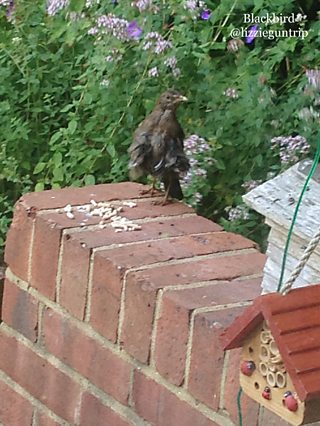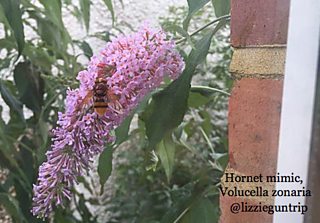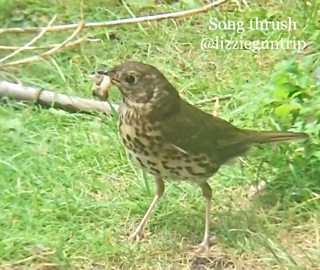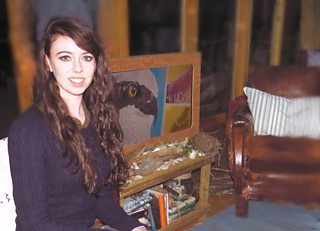Springwatch guest blogger Elizabeth Guntrip explains #WildlifeFromMyWindow, and her campaign for nature accesibility for all.
Resting on the sofa, I hear a churp-churp coming from just outside the lounge window. It is a blackbird – scruffy from moulting, her feathers spiking out at alarming angles as if she’s just received a static shock. She wants food. I put some suet pellets on the windowsill, as I do every day, and every day she returns, rewarding me by bringing her young to the garden or singing from the hedgetops. I’ve known this same blackbird for four years now, but the views from my window are ever-changing, ever-fascinating, ever-inspiring.

I have always been interested in the natural world – and for the first seventeen years of my life, my commitments took me to many beautiful, impressive places across the UK. But four years ago I was diagnosed with myalgic encephalomyelitis (shortened to M.E.). M.E. severely affects the cells of the body, limiting mobility, energy and stamina, and for eighteen months I was completely stuck at home.
Then, when I couldn’t get outside, the views of nature that I saw from my window became invaluable. For me it was my connection to the outside world, my solace, my way to escape. The wildlife I saw and heard from my window (and on television, where possible) was, for a time, the only accessible way I could maintain my interest for natural history. It brought joy; it brought escapism; it brought hope.

A hornet mimic hoverfly, Volucella Zonaria, is often a regular in gardens.
I became acutely aware that I was not alone in my experience. There are over 250,000 people with myalgic encephalomyelitis (case studies suggests this disease may be the most common cause of younger people being housebound) as well as 291,000 people living in care homes and 6.5 million carers. For many, many people across the UK, getting outside regularly is just not possible. The natural world is just as important, just as valuable to people with different circumstances. With the help of 主播大秀 Springwatch and Springwatch Extra, I am making a contribution towards helping us all to have a voice.
For the past year, as I have started to regain my strength, I have been fortunate enough to be able to help create a way for all people to share and celebrate their daily connection with nature. I set up a Twitter account - - as an accessible way to connect with other naturalists. Then on Springwatch in 2015 we launched a campaign called – an initiative through which people can embrace and share inclusive wildlife watching.
The aim of the campaign is to celebrate how nature uplifts and inspires. By using the hashtag on social media, and adding the usernames and @lizzieguntrip on Twitter, users can post their own views. The campaign, initially launched on 12th May with a post on , received over two and a half thousand responses in the first twenty-four hours – one of the most popular posts (cue me bursting into happy tears)! Responses are continuing to come in and by the time I went on the show, the campaign had been seen by over half a million people. We want to reach as many people as possible, to have a community that is fully inclusive, and a scheme that touches people’s hearts and inspires them.

On Springwatch Extra we explored ways to attract wildlife to your window – from bird feeders on washing lines to seed in window feeders, from window boxes and mini bucket ponds to wildlife gardening for those with limited space. Making a place that is appealing for wildlife can be as low energy as is necessary – it does not take much for wildlife to appear – and further ideas can be found on the Springwatch website and social media.
The stories so far are incredibly humbling. ‘Well done Springwatch’ and ‘thank you’ are in almost every post, but, more than this, there is a real celebration of nature as a ‘life line’, something to ‘lift spirits’ and ‘bring such joy’. Watching garden birds has been described as ‘the highlight of the day’, especially for the housebound, while bird song is both ‘melodic and uplifting’. I am continuing to be sent photographs of beloved wildlife characters in gardens across the country and beyond. I love it. There are posts from hospital windows, carers in the UK and those who, like me, are recovering from illnesses like M.E. To see how much it means for people to share their experiences of the natural world, whatever their circumstances, is incredibly moving.
Having spent a long time watching the wildlife from my own window, I have seen a huge range of wildlife sights. The more I watch, the more I see and, as such, the more I learn - and I hope to continue to share ways for people to enjoy accessible nature. We want to continue and grow and are always looking for ways to make this movement more inclusive. Whether it’s the views of foliage and flowers, the sounds of swifts or cross squirrels, or simply the electric-shock-look of moulting garden blackbird making people smile, nature should be enjoyed and celebrated by all. The blackbird’s chirping again – now where did I put that seed?

You can follow Elizabeth on Twitter - and follow the campain at
